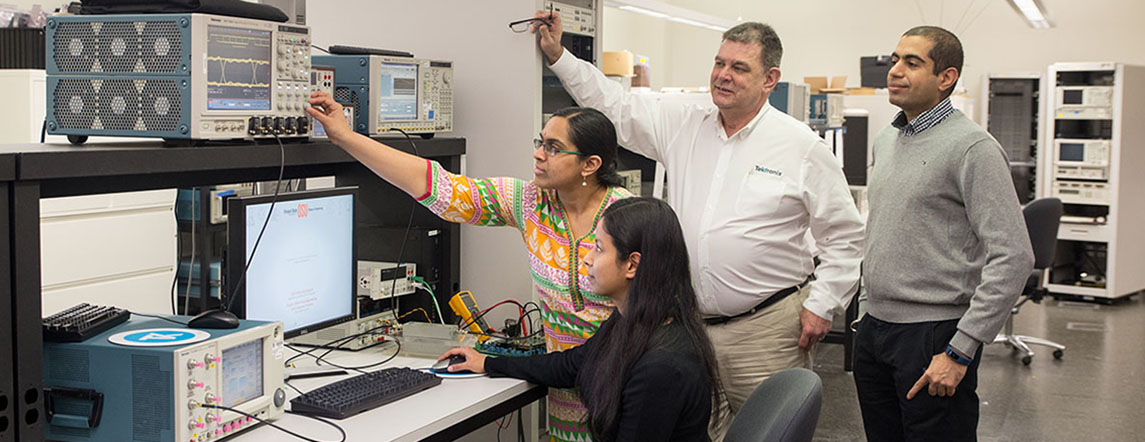Research at Oregon State University got a huge boost through an equipment donation from Tektronix that is enabling new innovations in the area of integrated electronics. The state-of-the-art testing equipment allows researchers to do more advanced work that will impact a broad range of devices including consumer electronics like cell phones and sensors that detect radiation.
The crown jewel is a new bit error rate tester (known as BERT) which tests new electronic devices to see how many errors are made during the transmission of a signal. It’s by far the most expensive (over $400,000) of the 13 testing devices in the upgrade.
“When students put it on a cart I keep telling them, ‘That's a house there,’” said Arun Natarajan, assistant professor of electrical and computer engineering. “It's a pretty sophisticated piece of equipment.”
In a lab where researchers are pushing the boundaries of data transmission speed, it is critical to have a device that can test at high rates. The new BERT can test at 28.6 gigahertz which is more than double their previous capacity. And already the tester has made a difference for the group that shares the Analog Mixed Signal Lab, including nine professors and 40 graduate students. This includes faculty and graduate students doing research for CDADIC, the Center for Design of Analog-Digital Integrated Circuits.
"Tektronix is committed to giving back to the community and our involvement with Oregon State is what we consider to be of strategic importance for the future of engineering." – Brandon Greenley
In less than a year, the group produced five published papers for which the Tektronix equipment was essential.
“We have a paper at the most important conference in circuits, which would not have been possible without having the bit error rate tester over the summer,” Natarajan said of a paper he co-authored with assistant professor, Tejasvi Anand and graduate student, Ashwin Ramachandran of electrical and computer engineering, which was presented in February at the IEEE International Solid-State Circuits Conference.
Another paper has been nominated for the Best Student Paper award in the flagship conference for microwave circuits (IEEE International Microwave Symposium) honoring the work of graduate students Kai Zhan and Ashwin Ramachandran. Both papers demonstrated proof of concept for new techniques of transmitting a signal over a channel which would improve speed and power efficiency of lower-cost components.
One of the more standard pieces of equipment that was part of the donation is a parameter analyzer, a tool used for measuring very small current and very small voltage of semi-conductor devices.
“Without it we can't well characterize our devices, and if we can't characterize our devices, we can't build circuits around them and ultimately build full sensor systems. So this is the first step in that chain,” said Matt Johnston, assistant professor of electrical and computer engineering. Johnston’s research includes chemical and biological sensing for applications such as air quality monitoring and medical diagnostics.
In addition to the donations and discounts from Tektronix, the new upgrades, valued at about $1 million, were made possible by a combination of faculty research funds, the College of Engineering, the School of Electrical Engineering and Computer Science, and the Research Office at Oregon State.
Tektronix has had a long established partnership with Oregon State including another equipment upgrade about 10 years ago and donations to support innovative education.
“Tektronix is committed to giving back to the community and our involvement with Oregon State is what we consider to be of strategic importance for the future of engineering,” said Brandon Greenley, general manager at Tektronix. “We want the best and brightest to come work for Tektronix when they finish their schooling, and a big part of that is making sure people have experiences and exposures to us as a company.”
And as an alumnus, Greenley has first-hand knowledge of how university-company partnerships can impact students, “I benefited greatly from Tektronix involvement with Oregon State when I was an undergraduate student, and then as a master's student, which ultimately led to my employment here,” he said.
Since the equipment is part of a shared lab the impact of the donation is amplified by the large number of users. Undergraduate students also use the lab equipment on occasion for their senior design projects.
“I've been in a traditional single faculty lab before, so I know how the equipment would sit on the shelf,” said Natarajan. “In our lab, there is a constant stream of students. We have five tests happening right now. So, the equipment is constantly in use.”



